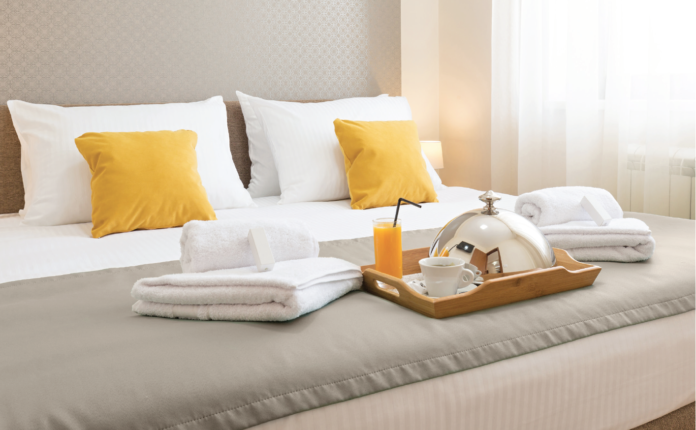Helena Drakakis checks into the hotel sector to discover the opportunity it presents to wholesalers
Holidaying closer to home is back in fashion. A weak pound, coupled with uncertainty over Brexit, has resulted in more people discovering what’s on their doorstep. After a dip last year, overseas visits to the UK in 2019 are also predicted to grow, with 38.9 million tourists spending £24.5bn.
The good news is that hotels are set to outperform the total eating-out market by 1.3% this year. For wholesalers, there are gains to be had by understanding this ever-changing market.
According to Sally Balcombe, chief executive of VisitBritain, more than a quarter of all domestic holidays are taken in July and August. However, off-peak holidaying is also growing thanks to all-weather activities including spa breaks.
The Staycation age group is also changing as “18-to-24-year-olds who take holidays are increasing the time they devote to UK breaks”, says Balcombe.
Understanding the market – whether urban or regional, or whether visitors are activity-seekers or sightseers – is key. “Wholesalers have to understand the hotel, what the target market is and what the demographic is, then replicate the key clients in the products they are offering,” says Rob Owen, business development executive chef at Creed Foodservice.
The breakfast opportunity
 Occupancy rates nationwide are 81%, so hotels already have a captive breakfast market. However, offering quality breakfasts and brunches may also attract day-trippers or locals.
Occupancy rates nationwide are 81%, so hotels already have a captive breakfast market. However, offering quality breakfasts and brunches may also attract day-trippers or locals.
According to Owen, there’s an opportunity in ambient and frozen to satisfy this market. Versatile, on-the-go breakfasts are also becoming more popular, particularly in urban areas.
“As well as pastries and traditional English cooked options, which consumers will enjoy at any time of the day, try American-style waffles with maple syrup and fresh fruit, croissants filled with bacon and egg, or bagels with smoked salmon and cream cheese. Many of these can be portable, too, making breakfast to go easy to introduce to the menu,” he says.
Smoothies, granola and low-fat yoghurts are also working their way into hotels, alongside hot drinks and alternative milks such as coconut or almond.
Bridging the meal gap
All-day dining has become a great way to bridge the meal gap, with brunches and afternoon teas being used to draw in visitors. Many conferences are held at hotels, so teas, coffees, sweets and snacks can also provide an extra revenue stream.
Buying group Caterforce, which produces its own-brand Chefs’ Selections range, says chefs are looking for cost-effective cakes that offer quality. “Afternoon tea is on the rise and our customers are trying to be more creative with their products.
“For example, we have taken the traditional Victoria sponge, upgraded the appearance and subtly added different flavours to make it more premium,” says group buying manager Kelly Orme.
Customers seeking value and quality are also evident when it comes to main meals. According to the MCA Eating Out Market Report 2019, average spend in hotel restaurants has fallen 1.3% year on year to £15.28. Here, says Bidfood, differentiation is key. For example, when it comes to hosting events such as weddings, bowl food is replacing the formal three-course sit-down meal.
“Celebrations are becoming about sharing and being a lot more casual, with people going for branded types of food and street food options,” says food development manager Damon Corey.
Adding value to the food offer
As well as offering great food, wholesalers that add value to customers through insight and information will have an edge. From trends advice, such as vegetarian and vegan options, to providing guidance about ingredients and allergens, wholesalers can pass on a wealth of knowledge and expertise to their catering customers.
Understanding food provenance is also increasingly desirable. “For more regional hotels, fresh local and British produce is important. You’ll find that the surrounding community chooses to dine on occasion, as well as hotel guests. Sustainability accreditations with meat and fish are also key,” says Creed’s Owen.
Increasing pressure on budgets means hoteliers are turning their attention to managing food waste, which currently costs the sector £318m. Crieff Hydro in Scotland, for example, cut its waste by £52,000 per year in its main Meikle restaurant, through simple measures such as using smaller buffet containers.
The hotel also sought environmentally friendly packaging and smaller pots for jams and marmalades. “Half our jam was being wasted. When we realised this, we got in touch with the wholesalers to look for alternatives,” says hotel environment manager Alexandra McDonald.
There is a range of opportunities to be explored within hotels, and this is only
going to increase.
Raising the bar: Examining foodservice’s relationship with the pub sector
Brewing up a storm: Examining wholesale’s relationship with coffee shops
Examining the channel’s relationship with the restaurant industry








